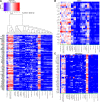Redefinition of the human mast cell transcriptome by deep-CAGE sequencing
- PMID: 24671954
- PMCID: PMC3999759
- DOI: 10.1182/blood-2013-02-483792
Redefinition of the human mast cell transcriptome by deep-CAGE sequencing
Abstract
Mast cells (MCs) mature exclusively in peripheral tissues, hampering research into their developmental and functional programs. Here, we employed deep cap analysis of gene expression on skin-derived MCs to generate the most comprehensive view of the human MC transcriptome ever reported. An advantage is that MCs were embedded in the FANTOM5 project, giving the opportunity to contrast their molecular signature against a multitude of human samples. We demonstrate that MCs possess a unique and surprising transcriptional landscape, combining hematopoietic genes with those exclusively active in MCs and genes not previously reported as expressed by MCs (several of them markers of unrelated tissues). We also found functional bone morphogenetic protein receptors transducing activatory signals in MCs. Conversely, several immune-related genes frequently studied in MCs were not expressed or were weakly expressed. Comparing MCs ex vivo with cultured counterparts revealed profound changes in the MC transcriptome in in vitro surroundings. We also determined the promoter usage of MC-expressed genes and identified associated motifs active in the lineage. Befitting their uniqueness, MCs had no close relative in the hematopoietic network (also only distantly related with basophils). This rich data set reveals that our knowledge of human MCs is still limited, but with this resource, novel functional programs of MCs may soon be discovered.
Figures




Comment in
-
Deep sequencing blood transcriptomes.Blood. 2014 Apr 24;123(17):2595-6. doi: 10.1182/blood-2014-03-563452. Blood. 2014. PMID: 24764555 No abstract available.
Similar articles
-
Deep sequencing blood transcriptomes.Blood. 2014 Apr 24;123(17):2595-6. doi: 10.1182/blood-2014-03-563452. Blood. 2014. PMID: 24764555 No abstract available.
-
Induction of differentiation of human mast cells from bone marrow and peripheral blood mononuclear cells by recombinant human stem cell factor/kit-ligand in long-term culture.Blood. 1992 Nov 1;80(9):2237-45. Blood. 1992. PMID: 1384799
-
How Relevant Are Bone Marrow-Derived Mast Cells (BMMCs) as Models for Tissue Mast Cells? A Comparative Transcriptome Analysis of BMMCs and Peritoneal Mast Cells.Cells. 2020 Sep 17;9(9):2118. doi: 10.3390/cells9092118. Cells. 2020. PMID: 32957735 Free PMC article.
-
Mast cell transcriptome elucidation: what are the implications for allergic disease in the clinic and where do we go next?Expert Rev Clin Immunol. 2014 Aug;10(8):977-80. doi: 10.1586/1744666X.2014.933074. Epub 2014 Jul 5. Expert Rev Clin Immunol. 2014. PMID: 24998292 Review.
-
Developmental origin and functional specialization of mast cell subsets.Immunity. 2012 Jul 27;37(1):25-33. doi: 10.1016/j.immuni.2012.07.003. Immunity. 2012. PMID: 22840841 Review.
Cited by
-
GRK2 inhibitors, paroxetine and CCG258747, attenuate IgE-mediated anaphylaxis but activate mast cells via MRGPRX2 and MRGPRB2.Front Immunol. 2022 Oct 6;13:1032497. doi: 10.3389/fimmu.2022.1032497. eCollection 2022. Front Immunol. 2022. PMID: 36275707 Free PMC article.
-
Transcription start site-level expression of thyroid transcription factor 1 isoforms in lung adenocarcinoma and its clinicopathological significance.J Pathol Clin Res. 2021 Jul;7(4):361-374. doi: 10.1002/cjp2.213. Epub 2021 May 20. J Pathol Clin Res. 2021. PMID: 34014042 Free PMC article.
-
Mast Cell and Basophil Granule Proteases - In Vivo Targets and Function.Front Immunol. 2022 Jul 5;13:918305. doi: 10.3389/fimmu.2022.918305. eCollection 2022. Front Immunol. 2022. PMID: 35865537 Free PMC article. Review.
-
Novel Insights Into the Immune-Regulatory Functions of Mast Cells in the Cutaneous Immune Response.Front Immunol. 2022 May 12;13:898419. doi: 10.3389/fimmu.2022.898419. eCollection 2022. Front Immunol. 2022. PMID: 35634300 Free PMC article. Review.
-
Activation of Mast-Cell-Expressed Mas-Related G-Protein-Coupled Receptors Drives Non-histaminergic Itch.Immunity. 2019 May 21;50(5):1163-1171.e5. doi: 10.1016/j.immuni.2019.03.013. Epub 2019 Apr 23. Immunity. 2019. PMID: 31027996 Free PMC article.
References
-
- Brown JM, Wilson TM, Metcalfe DD. The mast cell and allergic diseases: role in pathogenesis and implications for therapy. Clin Exp Allergy. 2008;38(1):4–18. - PubMed
-
- Navi D, Saegusa J, Liu FT. Mast cells and immunological skin diseases. Clin Rev Allergy Immunol. 2007;33(1-2):144–155. - PubMed
-
- Sayed BA, Christy A, Quirion MR, Brown MA. The master switch: the role of mast cells in autoimmunity and tolerance. Annu Rev Immunol. 2008;26:705–739. - PubMed
-
- Kneilling M, Röcken M. Mast cells: novel clinical perspectives from recent insights. Exp Dermatol. 2009;18(5):488–496. - PubMed
Publication types
MeSH terms
Substances
LinkOut - more resources
Full Text Sources
Other Literature Sources
Miscellaneous

